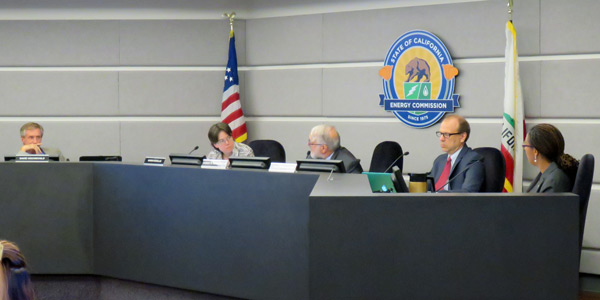By Jason Fordney
While reducing greenhouse gas emissions and increasing the use of renewable resources will remain top priorities for California for the foreseeable future, a biennial policy report by state energy planners has some environmentalists calling for even more aggressive pivots — such as phasing out utility-scale renewable projects.
The California Energy Commission is taking comments on its 2017 Integrated Energy Policy Report (IEPR) through Nov. 10. The current version released earlier this month lists many policy goals, including doubling energy efficiency savings, achieving 50% renewables by 2030, advancing the electrification of the transportation system and addressing barriers for low-income consumers in reaping the benefits of cleaner energy. The nearly 500-page document also discusses new technologies, transmission-scale planning, natural gas and climate issues, among other topics.

California Energy Commission members (from left): David Hochschild, Karen Douglas, Chair Robert Weisenmiller, Andrew McAllister, Janea Scott | © RTO Insiderf
Down with Centralization, Up with DER
Another key element in the state’s grid planning process is Renewable Energy Transmission Initiative (RETI) 2.0, which recognizes that greater reliance on renewable energy may require additional transmission or infrastructure improvements to achieve renewable energy goals and reduce emissions. The initiative is meant to facilitate electric transmission coordination and planning, and involves the CEC, the California Public Utilities Commission and CAISO.
RETI’s “landscape-scale” planning approach, included as a component of the IEPR, considers environmental conservation and other land uses, tribal cultural resources and stakeholder concerns to help identify the best areas for potential electric infrastructure development.
But some environmentalists calling into a Monday CEC workshop questioned the landscape-scale approach, saying that utility-scale generation, even for renewables, is an outdated concept. Planning agencies are “clinging to the outmoded notion that thousands of acres of desert land are needed for utility-scale projects,” with landscape-level planning leading the way, said Steve Mills, of the environmental group Alliance for Desert Preservation.
“Why do the energy agencies continue to reach for this old, familiar tool, which is a vestige of the outmoded centralized planning regime, when the IEPR makes it clear that it is time to throw away the whole toolbox?” Mills asked. He said the focus should be on energy efficiency, storage, distributed generation and other new technologies, not new utility-scale projects.
But Kate Kelly of Defenders of Wildlife said that the landscape-scale approach is the best one, and is “the tool to make informed decisions as when, where and how to site large-scale renewable energy development.”
Kelly said that while a move to distributed resources is desired, “That is not going to happen today, tomorrow or next week, and meanwhile we have to plan intelligently for renewable energy in a variety of places.”
CAISO this month issued a separate planning document, that envisions less fossil-fuel and nuclear resources by 2030, and a host of other proposals. (See CAISO Symposium Panelists Talk Grid of the Future, Western RTO.)
Transition from Gas
Reducing GHG emissions is not a new policy in California, but rapid changes in technology and resources are changing the way state planners must approach the electricity grid. The report notes the customer load currently served by investor-owned utilities could drop by 85% in the next 10 years. Chief among the new technological issues are renewable resource variability, the effect of DG on grid operations, and the impact of energy storage and electric vehicles.

| CAISO
The state reduced its CO2 output by 1.5 million metric tons between 2004 and 2014, a 10% decline. The electricity sector produces about 19% of California’s GHG, while the transportation sector emits 40%. The state accounts for about 1% of global GHG emissions.
The CEC is the primary policy-setting and planning energy agency in the state, and is responsible for certification and compliance of thermal power plants 50 MW and larger, including all project-related facilities.

California Energy Commission Chairman Robert Weisenmiller | © RTO Insider
NRG Energy recently indicated it will pull plans for a proposed 262-MW natural gas plant in Oxnard after Commissioners Janea Scott and Karen Douglas recommended the project not be approved. (See NRG Signals Pull-out on Proposed Puente Plant.) Distributed energy resources are alternatively planned to deal with the expected loss of generation in the area due to state rules prohibiting the use of once-through cooling at power plants.
Earlier this year, CEC Chair Robert Weisenmiller, who is quoted in the IEPR as desiring “a portfolio of solutions,” recommended permanent closure of the Aliso Canyon natural gas storage facility, saying it could be replaced with renewable energy, energy efficiency, electric storage and other tools. (See California Officials: Aliso Canyon Safe to Open.)


